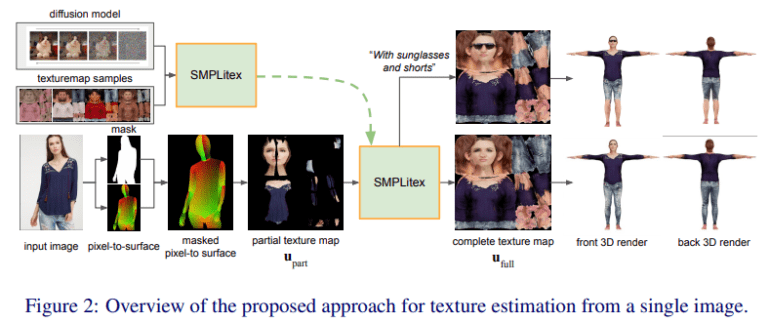TL;DR:
- SMPLitex is a game-changing solution in the field of computer vision, enabling realistic 3D human representations from 2D images.
- Traditional methods for 3D texture estimation face limitations, such as labor-intensive processes and handling occlusions.
- SMPLitex integrates generative models for 2D images into the 3D domain, excelling at pixel-to-surface correspondences.
- It accurately reconstructs 3D textures even for partially occluded subjects, setting new standards in human texture estimation.
- Rigorous evaluations confirm SMPLitex’s superiority over existing methods in both quantitative and qualitative assessments.
- SMPLitex’s versatility extends to various applications, including editing, synthesis, and manipulation of 3D textures.
Main AI News:
In the dynamic realm of computer vision and graphics, the quest for lifelike 3D human renderings from 2D images has been a formidable challenge. It’s not merely a technical obstacle; it’s a gateway to a multitude of applications, spanning from immersive virtual environments to advanced video editing. In response to this challenge, an innovative research team has unveiled a groundbreaking solution named “SMPLitex.” In this article, we delve into the core aspects of this research, including its methodology, intricacies, and the remarkable performance of SMPLitex.
The Visionary Pursuit of 3D Human Representation
The creation of 3D human representations from single images has been a long-standing aspiration in the realms of computer graphics and vision. While significant progress has been made in capturing 3D shapes, the elusive textures that imbue objects with realism have remained an imposing frontier. Imagine the ability to capture a single photograph of an individual and then effortlessly recreate their 3D shape, complete with intricate skin texture, clothing, and accessories. This is the audacious challenge that the research team behind SMPLitex has set out to conquer.
Navigating the Landscape of Existing Methods
Before delving into the intricacies of SMPLitex, it is crucial to grasp the existing methodologies and their inherent limitations. Traditional approaches have often relied on labor-intensive techniques, such as manual texture mapping or 3D scanning. These methods, while effective to a certain extent, may not be scalable for real-world applications. Moreover, they face significant hurdles when dealing with occlusions or incomplete views of the subject, limiting their practicality.
SMPLitex: Bridging the Gap
The research team behind SMPLitex has taken a bold leap forward by introducing a revolutionary method for estimating and manipulating the complete 3D appearance of humans captured in a single image. What sets SMPLitex apart is its unique integration of generative models initially designed for 2D images into the 3D domain. The key innovation lies in establishing pixel-to-surface correspondences based on the input image, which is then harnessed to reconstruct the 3D texture.
The Core of the Solution
At the heart of SMPLitex lies a generative model meticulously crafted for comprehensive 3D human appearance. This model undergoes extensive training to understand how human textures manifest in 3D space. However, the real magic unfolds when this model is conditioned on the visible aspects of the subject within the single input image.
Pixel-perfect Precision
SMPLitex achieves pixel-to-surface correspondences with astounding precision, seamlessly mapping the 2D image to its 3D counterpart. By leveraging this correspondence, SMPLitex can generate a complete 3D texture map that faithfully represents the subject’s appearance. The generative model’s adaptability to the visible portions of the image ensures that even when confronted with partially obscured subjects, SMPLitex delivers realistic 3D textures.
Proven Excellence
SMPLitex doesn’t just promise a paradigm shift; it delivers. The research team conducted rigorous quantitative and qualitative assessments across three publicly available datasets, and the results were nothing short of astounding. SMPLitex surpassed existing methods significantly, showcasing its prowess in human texture estimation.
Unleashing Versatility
One of the standout features of SMPLitex is its versatility. It excels in precise texture estimation and opens doors to a diverse array of tasks. Whether it’s editing, synthesis, or manipulation, SMPLitex seamlessly integrates 3D textures into various applications, enriching the realms of computer graphics and vision.

Source: Marktechpost Media Inc.
Conclusion:
SMPLitex represents a transformative leap in the field of computer graphics, unlocking the ability to generate lifelike 3D human textures from 2D images. By overcoming the limitations of traditional methods and offering precise texture mapping, SMPLitex not only revolutionizes human representation but also opens up new horizons for diverse applications. This breakthrough has the potential to reshape the market by providing advanced solutions for industries ranging from virtual reality to content creation, ultimately driving innovation and enhancing the user experience.

